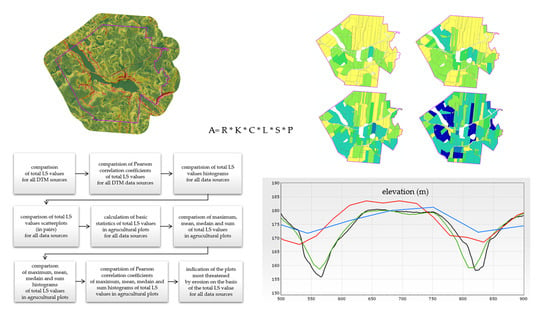Analysis of the Influence of DTM Source Data on the LS Factors of the Soil Water Erosion Model Values with the Use of GIS Technology
Abstract
:1. Introduction
- A = mean annual soil loss (in t ha−1 yr−1),
- R = rainfall erosivity factor (in MJ mm ha−1 h−1 yr−1),
- K = soil erodibility factor (in t h MJ−1 mm−1),
- C = cover management factor (dimensionless),
- L = slope length factor (dimensionless),
- S = slope steepness factor (dimensionless) and
- P = support practice factor (dimensionless).
2. Materials and Methods
2.1. Study Areas
2.2. DTM Source Data
2.3. USLE/RUSLE LS Formulas Implementation
- • stage 1
- determination of the mask of agricultural areas inside the research areas (exclusion of nonagricultural part from statistics calculation),
- • stage 2
- detailed comparative analyses of elevation values and slope values obtained from various DTM source data,
- • stage 3
- calculation of the values of the L and S factors in accordance with the adopted formulas and with use of various DTM source data and
- • stage 4
- detailed analyses of the total value of the LS factors obtained from different DTM source data.
- LS SUM i: the total value of LS factors obtained for the agricultural plot based on SRTM, DTED2 and LPIS;
- LS SUM ISOK: the total value of LS factors obtained for the agricultural plot based on ISOK.
3. Results
3.1. DTM Elevation and Slopes Comparison
3.2. Comparison of the Total LS Factors Values
3.3. Comparison of the Total Values of the LS Factors in Agricultural Plots
- a decrease in the value of the sum of the total LS factor values in the plot,
- a decrease in the percentage of plots with high values of the sum of the total LS factor values and
- a significant increase in the maximum of the total LS factor values in the plot as the accuracy and detail of the source DTM increases.
4. Discussion
5. Conclusions
Funding
Acknowledgments
Conflicts of Interest
Appendix A


Appendix B
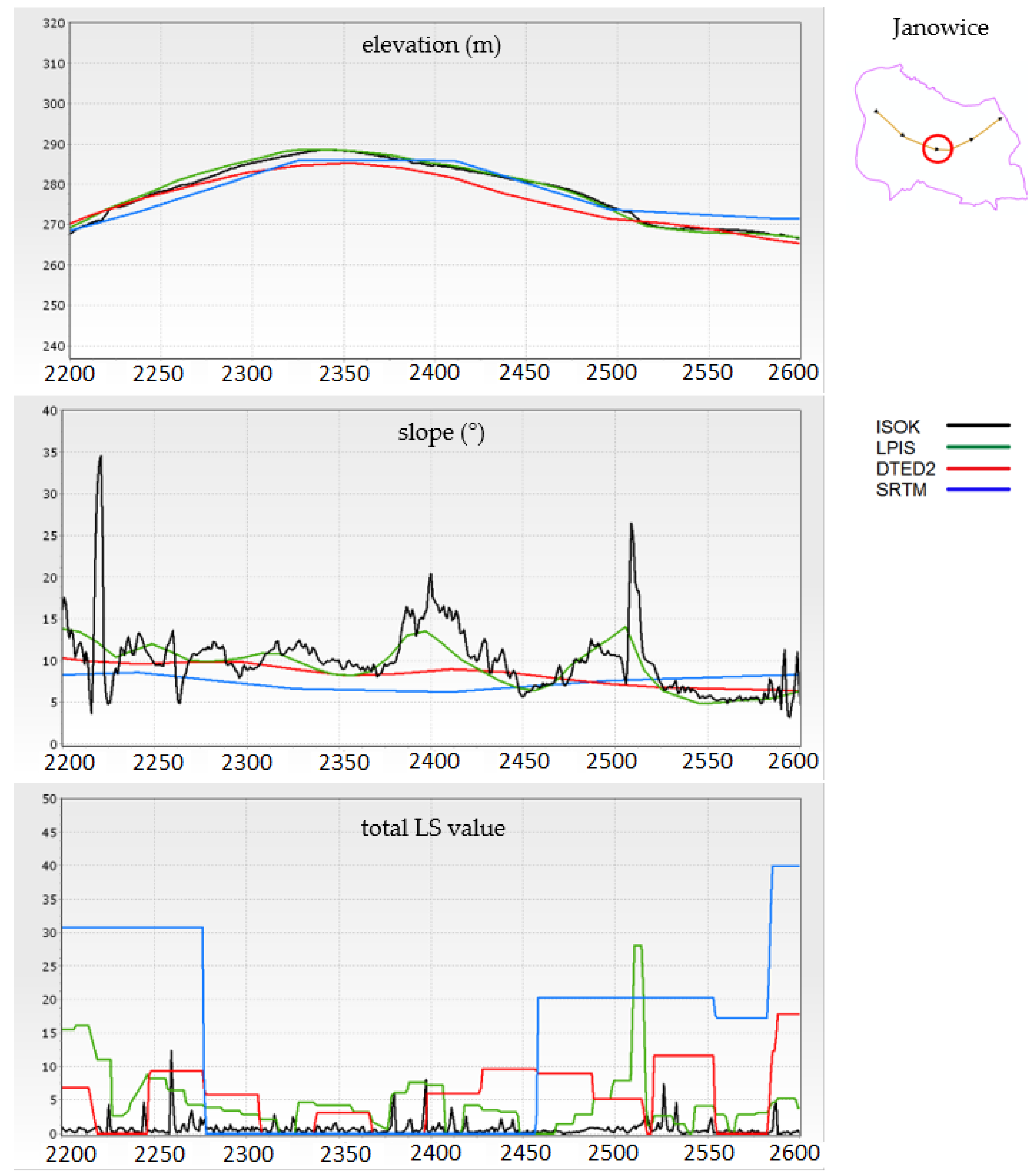
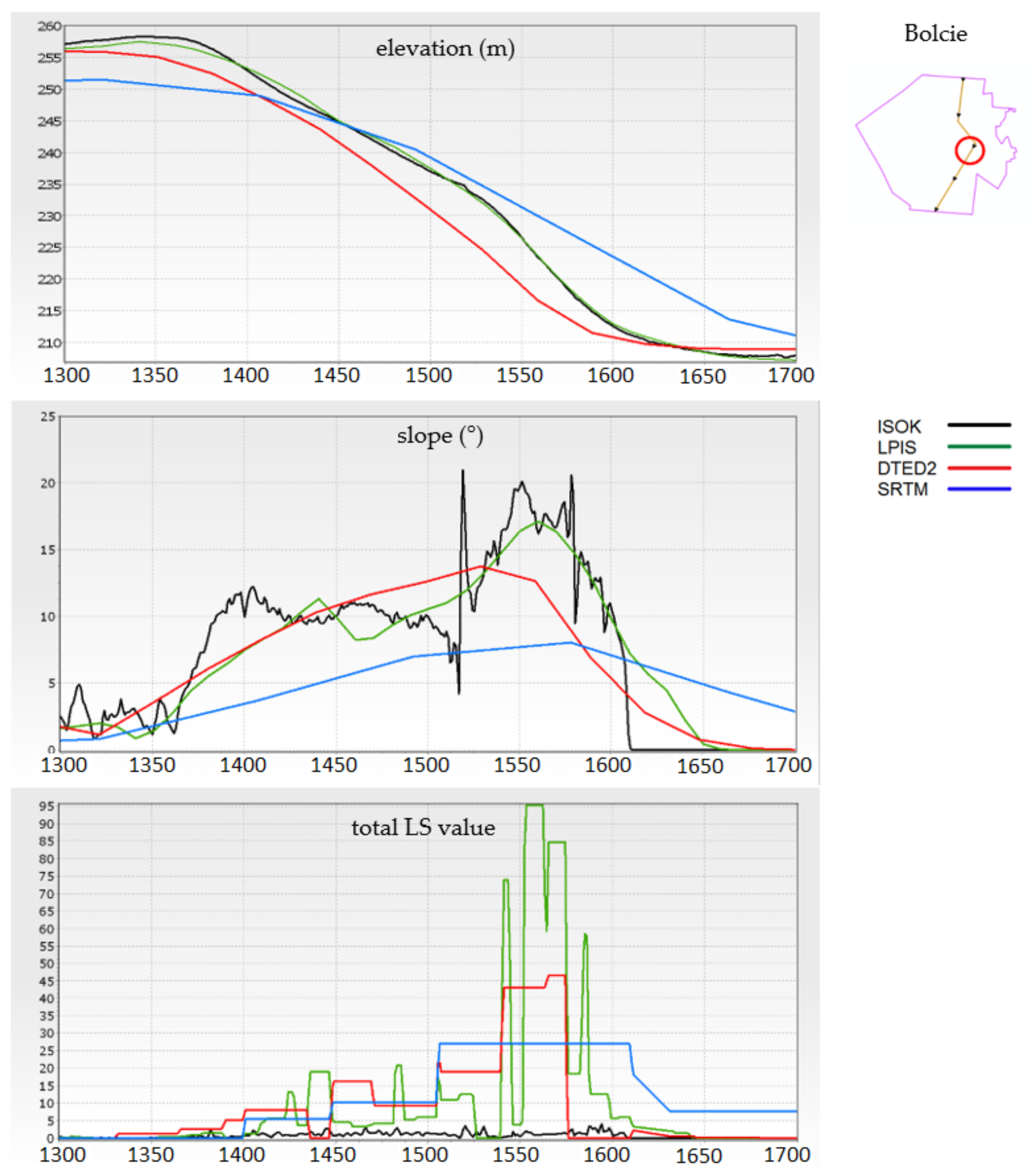
Appendix C
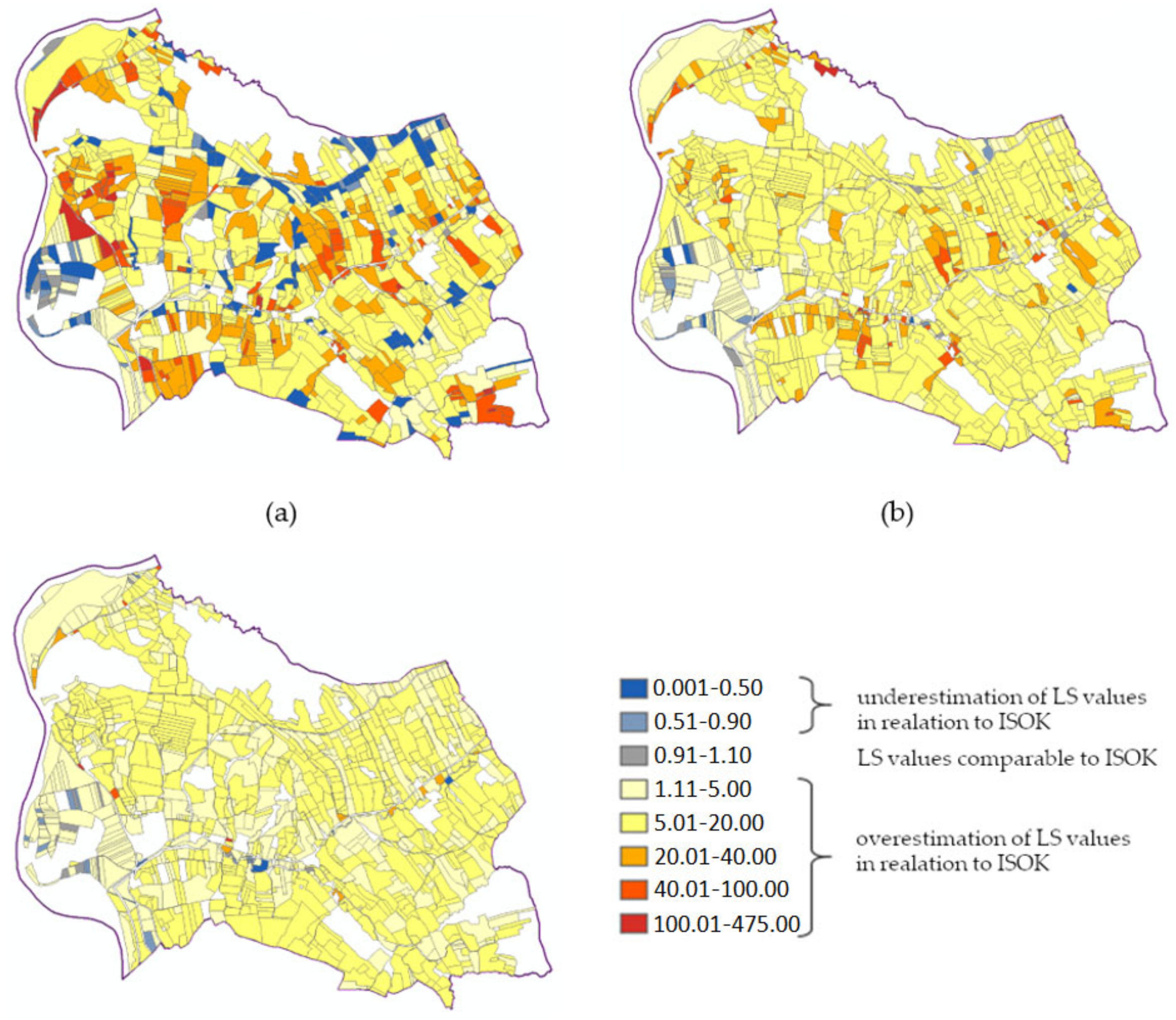
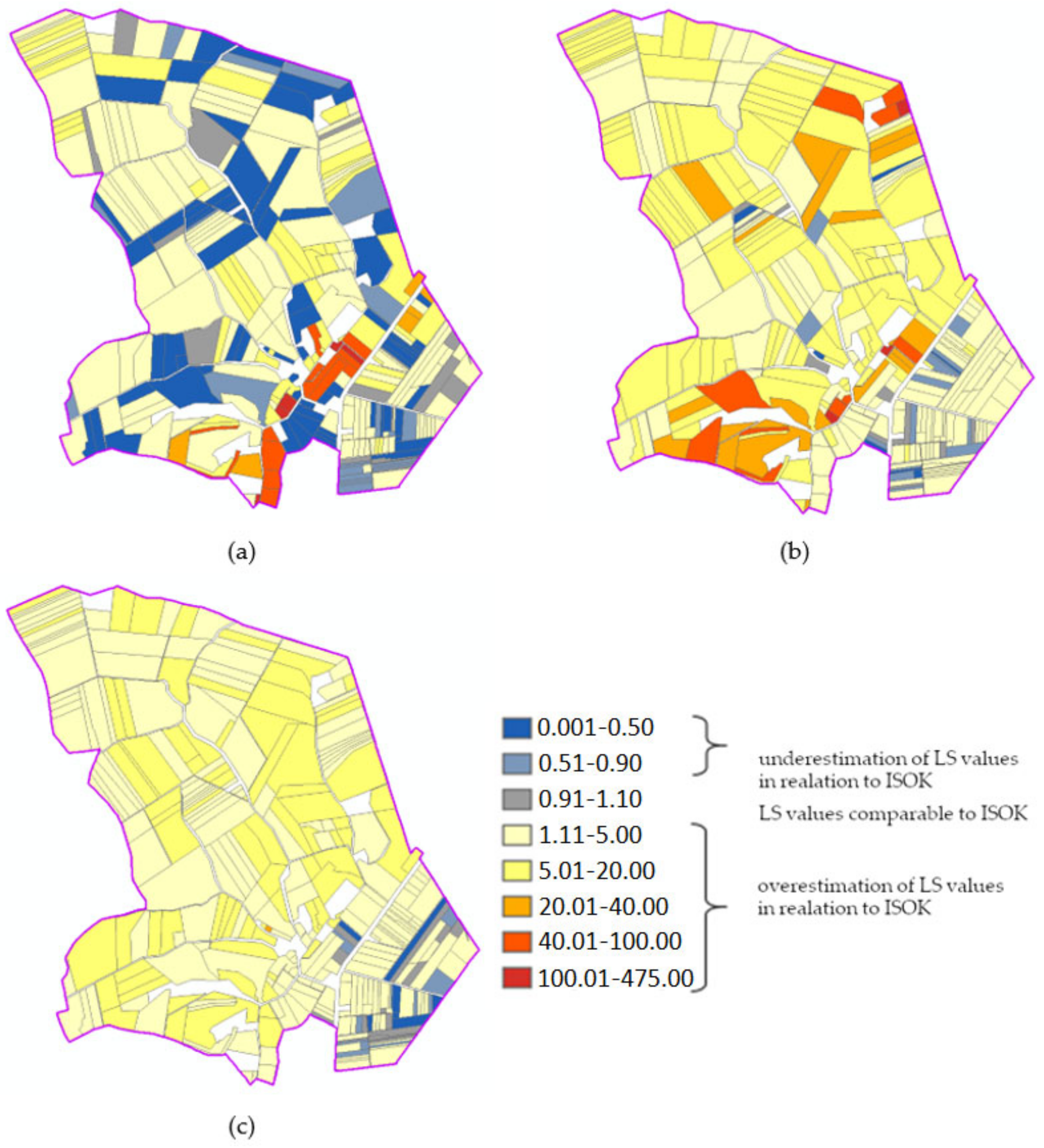
References
- FAO; ITPS. Status of the World’s Soil Resources (SWSR)–Main Report; Food and agriculture organization of the United Nations and intergovernmental technical panel on soils: Rome, Italy, 2015; 650p. [Google Scholar]
- Montanarella, L.; Vargas, R. Global governance of soil resources as a necessary condition for sustainable development. IOP Conf. Ser. Earth Environ. Sci. 2012, 4, 559–564. [Google Scholar] [CrossRef]
- Eckelmann, W.; Baritz, R.; Bialousz, S.; Bielek, P.; Carré, F.; Hrušková, B.; Tóth, G. Common criteria for risk area identification according to soil threats. In Office for Official Publications of the European Communities; European Communities: Brussels, Belgium, 2006; p. 94. [Google Scholar]
- Renard, K.G.; Foster, G.R. Soil conservation: Principles of erosion by water. In Dryland Agriculture, Agronomy Monogr; Degne, H.E., Willis, W.O., Eds.; John Wiley & Sons, Inc.: Madison, WI, USA, 1983; Volume 23, pp. 156–176. [Google Scholar]
- Mitra, B.; Scott, H.D.; Dixon, J.C.; McKimmey, J.M. Applications of fuzzy logic to the prediction of soil erosion in a large watershed. Geoderma 1998, 86, 183–209. [Google Scholar] [CrossRef]
- Bauer, F.C.; Dyson, J.; Balsari, P.; Marucco, P. Best Management Practices to Reduce Water Pollution with Plant Protection Products from Run-Off and Erosion; European Crop Protection Association: Brussels, Brussels, 2014; Available online: http://www.topps-life.org (accessed on 21 December 2020).
- Janicki, G. System Stoku Zmywowego i jego Modelowanie Statystyczne–na Przykładzie Wyżyn Lubelsko-Wołyńskich (Wash Slope Systems and Their Statistical Modelling–Case Study from the Lublin-Volhynian Uplands); Wydawnictwo Uniwersytetu Marii Curie-Skłodowskiej: Lublin, Poland, 2016; p. 309. [Google Scholar]
- Rejman, J. Wpływ erozji wodnej i uprawowej na przekształcenie gleb i stoków lessowych. Acta Agrophysica 2006, 3, 90. [Google Scholar]
- Poesen, J.; Nachtergaele, J.; Verstraeten, G.; Valentin, C. Gully erosion and environmental change: Importance and research needs. Catena 2003, 50, 91–133. [Google Scholar] [CrossRef]
- Rejman, J.; Brodowski, R. Ocena erozji wodnej gleby lessowej na uprawach buraka cukrowego i pszenicy jarej na podstawie badań poletkowych. Procesy erozyjne na stokach użytkowanych rolniczo (metody badań, dynamika i skutki). Prace i Studia Geograficzne Uniwersytetu Warszawskiego 2010, 45, 215–228. [Google Scholar]
- Karydas, C.G.; Panagos, P.; Gitas, I.Z. A classification of water erosion models according to their geospatial characteristics. Int. J. Digit. Earth 2012, 7, 229–250. [Google Scholar] [CrossRef]
- Poesen, J. Soil erosion in the Anthropocene: Research needs. Earth Surf. Proc. Landf. 2018, 43, 64–84. [Google Scholar] [CrossRef]
- Rodzik, J.; Stępniewski, K. Spłukiwanie na zróżnicowanych litologicznie użytkowanych rolniczo stokach Roztocza Środkowego. In Współczesna Ewolucja rzeźby Polski, Instytut Geografii i Gospodarki Przestrzennej; Kotarba, A., Krzemień, K., Święchowicz, J., Eds.; Uniwersytet Jagielloński: Kraków, Poland, 2005; pp. 389–395. [Google Scholar]
- Kirkby, M. Modelling the interactions between soil surface properties and water erosion. Catena 2002, 46, 89–102. [Google Scholar] [CrossRef]
- Słupik, J. Rola Stoku w Kształtowaniu Odpływu w Karpatach Fliszowych; IGiPZ PAN; Zakład narodowy im. Ossolińskich: Lviv, Ukraine, 1981; p. 142. [Google Scholar]
- Froehlich, W.; Słupik, J. Mechanizm transportu fluwialnego i dostawy zwietrzelin do koryta w górskiej zlewni fliszowej. Przegląd Geograficzny 1986, 58, 67–87. [Google Scholar]
- Wischmeir, W.H.; Smith, D.D. Predicting Rainfall Erosion Losses–a Guide to Conservation Planning, Agriculture Handbook No. 537, U.S. Department of Agriculture Technical Report; U.S. Department of Agriculture: Washington, DC, USA, 1978; p. 58.
- Renard, K.G.; Foster, G.R.; Weesies, G.A.; McCool, D.K.; Yoder, D.C. Predicting Soil Erosion by Water: A guide to Conservation Panning with the Revised Universal Soil Loss Equation (RUSLE); United States Department of Agriculture: Washington, DC, USA, 1997; Volume 703, p. 407.
- Desmet, P.; Govers, G. A GIS procedure for automatically calculating the USLE LS factor on topographically complex landscape units. J. Soil Water Conserv. 1996, 51, 427–433. [Google Scholar]
- Zhang, L.; O’Neill, A.L.; Lacey, S. Modelling approaches to the prediction of soil erosion in catchments. Environ. Softw. 1996, 11, 123–133. [Google Scholar] [CrossRef]
- Rejman, J.; Usowicz, B.; Dębicki, R. Source of errors in predicting silt soil erodibility with USLE. Pol. J. Soil Sci. 1999, 32, 13–22. [Google Scholar]
- Schiettecatte, W.; Gabriëls, D.; Van Meirvenne, M.; Biesemans, J. Simulatie van erosiebestrijdingsmaatregelen aan de hand van het RUSLE model: Een case-studie in het stroomgebied van de Markebeek (Oost-Vlaanderen). Water Energ. Leefmilieu 1999, 18, 1–8. [Google Scholar]
- Liu, B.Y.; Nearing, M.A.; Shi, P.J.; Jia, Z.W. Slope length effects on soil loss for steep slopes. Soil Sci. Soc. Am. J. 2000, 64, 1759–1763. [Google Scholar] [CrossRef] [Green Version]
- Nyakatawa, E.Z.; Reddy, K.C.; Lemunyon, J.L. Predicting soil erosion in conservation tillage cotton production systems using the revised universal soil loss equation (RUSLE). Soil Tillage Res. 2001, 57, 213–222. [Google Scholar] [CrossRef]
- Rejman, J.; Usowicz, B. Evaluation of soil-loss contribution areas on loess soils in southeast Poland. Earth Surf. Proc. Land. 2002, 27, 1415–1423. [Google Scholar] [CrossRef]
- Grimm, M.; Jones, R.; Montanarella, L. Soil Erosion Risk in Europe, Joint Research Centre, Scientific-Technical Report EUR 19939 EN; European Commission: Brussels, Belgium, 2001; p. 38. [Google Scholar]
- Drzewiecki, W.; Mularz, S. Model USPED jako narzędzie prognozowania efektów erozji i depozycji materiału glebowego. Rocz. Geom. Ann. Geom. 2005, 3, 45–54. [Google Scholar]
- Borrelli, P.; Robinson, D.A.; Fleischer, L.R.; Lugato, E.; Ballabio, C.; Alewell, C.; Bagarello, V. An assessment of the global impact of 21st century land use change on soil erosion. Nat. Commun. 2017, 8, 1–13. [Google Scholar] [CrossRef] [Green Version]
- Kinnell, P.I.A. Sediment delivery from hillslopes and the Universal Soil Loss Equation: Some perceptions and misconceptions. Hydrol. Process. 2008, 22, 3168–3175. [Google Scholar] [CrossRef]
- Kirkby, M.; Jones, R.J.; Irvine, B.; Gobin, A.G.G.; Cerdan, O.; van Rompaey, J.J.; Grimm, M. Pan-European Soil Erosion Risk Assessment for Europe: The PESERA map, version 1 October 2003, Explanation of Special Publication Ispra 2004 No. 73 (SPI 04.73) (No. 16, 21176); Office for Official Publications of the European Communities: Brussels, Belgium, 2004; p. 21. [Google Scholar]
- Bagarello, V.; Ferro, V. Analysis of soil loss data from plots of differing length for the Sparacia experimental area, Sicily, Italy. Biosyst. Eng. 2010, 105, 411–422. [Google Scholar] [CrossRef]
- Cerdan, O.; Govers, G.; le Bissonnais, Y.; van Oost, K.; Poesen, J.; Saby, N.; Gobin, A.; Vacca, A.; Quinton, J.; Auerswald, K.; et al. Rates and spatial variations of soil erosion in Europe, A study based on erosion plot data. Geomorphology 2010, 122, 167–177. [Google Scholar] [CrossRef]
- Kinnell, P.I.A. Slope length factor for applying the USLE-M to erosion in grid cells. Soil Tillage Res. 2001, 58(1–2), 11–17. [Google Scholar] [CrossRef]
- Parveen, R.; Kumar, U. Integrated Approach of Universal Soil Loss Equation (USLE) and Geographical Information System (GIS) for Soil Loss Risk Assessment in Upper South Koel Basin, Jharkhand. J. Geogr. Syst. 2012, 4, 588–596. [Google Scholar] [CrossRef] [Green Version]
- Wężyk, P.; Drzewiecki, W.; Wójtowicz-Nowakowska, A.; Pierzchalski, M.; Mlost, J.; Szafrańska, B. Mapa zagrożenia erozyjnego gruntów rolnych w Małopolsce na podstawie klasyfikacji OBIA obrazów teledetekcyjnych oraz analiz przestrzennych GIS, Archives of Photogrammetry. Cartogr. Remote Sens. 2012, 24, 403–420. [Google Scholar]
- Zhang, H.; Yang, Q.; Li, R.; Liu, Q.; Moore, D.; He, P.; Geissen, V. Extension of a GIS procedure for calculating the RUSLE equation LS factor. Comput. Geosciences 2013, 52, 177–188. [Google Scholar] [CrossRef]
- Drzewiecki, W.; Ziętara, S. Wpływ algorytmu określania dróg spływu powierzchniowego na wyniki oceny zagrożenia gleb erozją wodną w skali zlewni z zastosowaniem modelu RUSLE. Rocz. Geom. Ann. Geom. 2013, 11, 57–68. [Google Scholar]
- Bargiel, D.; Herrmann, S.; Jadczyszyn, J. Using high-resolution radar images to determine vegetation cover for soil erosion assessments. J. Environ. Manag. 2013, 124, 82–90. [Google Scholar] [CrossRef]
- Oliveira, A.H.; da Silva, M.A.; Silva, M.L.N.; Curi, N.; Neto, G.K.; de Freitas, D.A.F. Development of topographic factor modeling for application in soil erosion models. In Soil Processes and Current Trends in Quality Assessment; Soriano, M.C.H., Ed.; Intech Open: London, UK, 2013; pp. 111–138. ISBN 978-953-51-1029-3. [Google Scholar] [CrossRef] [Green Version]
- Evelpidou, N.; Cordier, S.; Merino, A.; Figueiredo, T.D.; Centeri, C. (Eds.) Runoff Erosion, University of Athens. 2013, p. 378. Available online: http://hdl.handle.net/10198/11228 (accessed on 21 December 2020).
- Panagos, P.; Meusburger, K.; Ballabio, C.; Borrelli, P.; Alewell, C. Soil erodibility in Europe: A high-resolution dataset based on LUCAS. Sci. Total Environ. 2014, 479–480, 189–200. [Google Scholar] [CrossRef]
- Panagos, P.; Borrelli, P.; Meusburger, K. A New European Slope Length and Steepness Factor (LS-Factor) for Modeling Soil Erosion by Water. Geosciences 2015, 5, 117–126. [Google Scholar] [CrossRef] [Green Version]
- Panagos, P.; Borrelli, P.; Poesen, J.; Ballabio, C.; Lugato, E.; Meusburger, K.; Montanarella, L.; Alewell, C. The new assessment of soil loss by water erosion in Europe. Environ. Sci. Policy. 2015, 54, 438–447. [Google Scholar] [CrossRef]
- Bosco, C.; de Rigo, D.; Dewitte, O.; Poesen, J.; Panagos, P. Modelling soil erosion at European scale: Towards harmonization and reproducibility. Nat. Hazards Earth Syst. Sci. 2015, 15, 225–245. [Google Scholar] [CrossRef] [Green Version]
- Bagio, B.; Bertol, I.; Wolschick, N.H.; Schneiders, D.; dos Santos, M.A.N. Water erosion in different slope lengths on bare soil. Revista Brasileira de Ciência do Solo 2017, 41. [Google Scholar] [CrossRef] [Green Version]
- Hajigholizadeh, M.; Melesse, A.M.; Fuentes, H.R. Erosion and sediment transport modelling in shallow waters: A review on approaches, models and applications. Int. J. Environ. Res. Public Health 2018, 15, 518. [Google Scholar] [CrossRef] [Green Version]
- Karydas, C.G.; Panagos, P. The G2 erosion model: An algorithm for month-time step assessments. Environ. Res. 2018, 161, 256–267. [Google Scholar] [CrossRef]
- Schmidt, S.; Tresch, S.; Meusburger, K. Modification of the RUSLE slope length and steepness factor (LS-factor) based on rainfall experiments at steep alpine grasslands. MethodsX 2019, 6, 219–229. [Google Scholar] [CrossRef]
- Zachar, D. Soil Erosion; Elsevier Scientific Publishing Company: Bratislava, Slovakia, 1982; Volume 10, p. 549. [Google Scholar]
- Risse, L.M.; Nearing, M.A.; Nicks, A.D.; Laflen, J.M. Assessment of error in the universal soil loss equation. Soil Sci. Soc. Am. J. 1993, 57, 825–833. [Google Scholar] [CrossRef]
- Roose, E. Land Husbandry–Components and Strategy; FAO: Rome, Italy, 1996; Volume 70, Available online: http://www.fao.org/3/t1765e/t1765e00.htm (accessed on 21 December 2020).
- Tetzlaff, B.; Friedrich, K.; Vorderbrügge, T.; Vereecken, H.; Wendland, F. Distributed modelling of mean annual soil erosion and sediment delivery rates to surface waters. Catena 2013, 102, 13–20. [Google Scholar] [CrossRef]
- Moore, I.D.; Burch, G.J. Physical basis of the length-slope factor in the Universal Soil Loss Equation. Soil Sci. Soc. Am. J. 1986, 50, 1294–1298. [Google Scholar] [CrossRef]
- Moore, I.D.; Wilson, J.P. Length-slope factors for the revised universal soil loss equation: Simplified method or estimation. J. Soil Wat. Conserv. 1992, 45, 423–428. [Google Scholar]
- Mitasova, H.; Hofierka, J.; Zlocha, M.; Iverson, R.L. Modeling topographic potential for erosion and deposition using GIS. Int. J. Geogr. Inf. Syst. 1996, 10, 629–641. [Google Scholar] [CrossRef]
- Wilson, J.P.; Mitasova, H.; Wright, D.J. Water resource applications of geographic information systems. Urisa J. 2000, 12, 61–79. [Google Scholar]
- Liu, K.; Tang, G.; Jiang, L.; Zhu, A.X.; Yang, J.Y.; Song, X.D. Regional-scale calculation of the LS factor using parallel processing. Comput. Geosci. 2015, 78, 110–122. [Google Scholar] [CrossRef]
- Wilson, J.P.; Gallant, J.C. Terrain Analysis: Principles and Applications; John Wiley & Sons: New York, NY, USA, 2000; p. 479. [Google Scholar]
- Zhou, Q.; Lees, B.; Tang, G.A. (Eds.) Advances in Digital Terrain Analysis; Springer: Berlin, Germany, 2008; p. 462. [Google Scholar]
- Erskine, R.H.; Green, T.R.; Ramirez, J.A.; MacDonald, L.H. Comparison of grid-based algorithms for computing upslope contributing area. Water Resour. Res. 2006, 42, W09416. [Google Scholar] [CrossRef] [Green Version]
- Wilson, J.P.; Lam, C.S.; Deng, Y. Comparison of the performance of flow routing algorithms used in GIS-based hydrologic analysis. Hydrol. Process. 2007, 21, 1026–1044. [Google Scholar] [CrossRef]
- Xiong, L.; Tang, G.; Yan, S.; Zhu, S.; Sun, Y. Landform-oriented flow-routing algorithm for the dual-structure loess terrain based on digital elevation models. Hydrol. Process. 2013, 28, 1756–1766. [Google Scholar] [CrossRef]
- Renard, K.G.; Foster, G.R.; Weesies, G.A.; Porter, J.P. RUSLE: Revised universal soil loss equation. J. Soil Water Conserv. 1991, 46, 30–33. [Google Scholar]
- Pimentel, D.; Harvey, C.; Resosudarmo, P.; Sinclair, K.; Kurz, D.; McNair, M.; Crist, S.; Shpritz, L.; Fitton, L.; Saffouri, R.; et al. Environmental and economic costs of soil erosion and conservation benefits. Science 1995, 267, 1117–1123. [Google Scholar] [CrossRef] [PubMed] [Green Version]
- Józefaciuk, A.; Józefaciuk, C. Erozja Agroekosystemów, Państwowa Inspekcja Ochrony Środowiska; Biblioteka Monitoringu Środowiska: Warszawa, Poland, 1995; p. 168. [Google Scholar]
- Maetens, W.; Vanmaercke, M.; Poesen, J.; Jankauskas, B.; Jankauskiene, G.; Ionita, I. Effects of land use on annual runoff and soil loss in Europe and the Mediterranean: A meta-analysis of plot data. Prog. Phys. Geogr. 2012, 36, 599–653. [Google Scholar] [CrossRef]
- Biesemans, J.; Van Meirvenne, M.; Gabriels, D. Extending the RUSLE with the Monte Carlo error propagation technique to predict long-term average off-site sediment accumulation. J. Soil Water Conserv. 2000, 55, 35–42. [Google Scholar]
- Yang, D.; Kanae, S.; Oki, T.; Koike, T.; Musiake, K. Global potential soil erosion with reference to land use and climate changes. Hydrol. Process. 2003, 17, 2913–2928. [Google Scholar] [CrossRef]
- Hohwieler, N.K. Quantification of soil erosion in the Alps: Measurement and Modeling. Ph.D. Thesis, University of Basel, Basel, Switzerland, 2010; p. 101. [Google Scholar]
- Drzewiecki, W.; Wężyk, P.; Pierzchalski, M.; Szafrańska, B. Quantitative and qualitative assessment of soil erosion risk in Małopolska (Poland), supported by an object-based analysis of high-resolution satellite images. Pure Appl. Geophys. 2014, 171, 867–895. [Google Scholar] [CrossRef] [Green Version]
- Kowalczyk, A.; Twardy, S. Wielkość erozji wodnej obliczona metodą USLE. Woda-Środowisko-Obszary Wiejskie 2012, 12, 83–92. Available online: https://portal.issn.org/resource/ISSN/1642-8145 (accessed on 21 December 2020).
- Ferreira, V.; Panagopoulos, T. Predicting Soil Erosion Risk at the Alqueva Dam Watershed (No. 2012-4); CIEO-Research Centre for Spatial and Organizational Dynamics, University of Algarve: Faro, Portugal, 2012. [Google Scholar]
- Ferreira, V.; Panagopoulos, T. Seasonality of soil erosion under Mediterranean conditions at the Alqueva dam watershed. Environ. Manag. 2014, 54, 67–83. [Google Scholar] [CrossRef]
- Csáfordi, P.; Pődör, A.; Bug, J.; Gribovsyki, Z. Soil erosion analysis in a small forested catchment supported by ArcGIS Model Builder. Acta Silvatica et Lignaria Hungarica 2012, 8, 39–56. [Google Scholar] [CrossRef] [Green Version]
- Conforti, M.; Buttafuoco, G.; Rago, V.; Aucelli, P.P.; Robustelli, G.; Scarciglia, F. Soil loss assessment in the Turbolo catchment (Calabria, Italy). J. Maps. 2016, 12, 815–825. [Google Scholar] [CrossRef]
- Capolongo, D.; Pennetta, L.; Piccarreta, M.; Fallacara, G.; Boenzi, F. Spatial and temporal variations in soil erosion and deposition due to land-levelling in a semi-arid area of Basilicata (Southern Italy). Earth Surf. Process. Landf. 2008, 33, 364–379. [Google Scholar] [CrossRef]
- Pregnolato, M.; D’Amico, M. Water Regime in the Alpine Space: Soil Erosion in a Changing Environment. Tech. Rep. 2011, 84. [Google Scholar]
- Ducci, D.; Giugni, M.; Zampoli, M. Evaluation of soil erosion process of the Tusciano river basin. In Proceedings of the COST Soil and Hillslope Management using Analysis and Runoff-Erosion Models: A Critical Evaluation of Current Technique, Florence, Italy, 7–9 May 2007; CNR-IRPI National Research Council Research Institute for GeoHydrological Protection: Bari, Italy, 2007; pp. 30–36. [Google Scholar]
- Rodriguez, J.L.G.; Suarez, M.C.G. Methodology for estimating the topographic factor LS of RUSLE3D and USPED using GIS. Geomorphology 2012, 175, 98–106. [Google Scholar] [CrossRef]
- Barrena-González, J.; Rodrigo-Comino, J.; Gyasi-Agyei, Y.; Pulido, M.C. Applying the RUSLE and ISUM in the Tierra de Barros Vineyards (Extremadura, Spain) to Estimate Soil Mobilisation Rates. Land 2020, 9, 93. [Google Scholar] [CrossRef] [Green Version]
- Covelli, C.; Cimorelli, L.; Pagliuca, D.N.; Molino, B.; Pianese, D. Assessment of Erosion in River Basins: A Distributed Model to Estimate the Sediment Production over Watersheds by a 3-Dimensional LS Factor in RUSLE Model. Hydrology 2020, 7, 13. [Google Scholar] [CrossRef] [Green Version]
- Xanthakis, M.; Minetos, P.; Lisitsa, G.; Kamari, G. Numerical Modelling of Soil Erosion on Cephalonia Island, Greece Using Geographical Information Systems and the Revised Universal Soil Loss Equation (RUSLE). Proceedings 2018, 2, 618. [Google Scholar] [CrossRef] [Green Version]
- Zhao, Z.; Benoy, G.; Chow, T.; Rees, H.; Daigle, J.-L.; Meng, F.-R. Impacts of Accuracy and Resolution of Conventional and LiDAR Based DEMs on Parameters Used in Hydrologic Modeling. Water Resour. Manag. 2010, 24, 1363–1380. [Google Scholar] [CrossRef]
- Mitasova, H.; Barton, C.M.; Ullah, I.I.T.; Hofierka, J.; Harmon, R.S. GIS-based soil erosion modeling. In Treatise in Geomorphology: Vol. 3 Remote Sensing and GI Science in Geomorphology; Shroder, J., Bishop, M., Eds.; Academic Press: San Diego, CA, USA, 2013; pp. 228–258. [Google Scholar] [CrossRef]
- Holata, L.; Kapička, J.; Světlík, R.; Žížala, D. Risk Management as a Stimulus for a Settlement and Landscape Transformation? Soil Erosion Threat Assessment in the Fields of Four Deserted Villages Based on LiDAR-Derived DEMs and ‘USLE’. In Proceedings of the GIS Ostrava, Ostrava, Czech Republic, 22–24 March 2017; Springer: Berlin, Germany, 2017; pp. 131–147. [Google Scholar]
- Harmon, R.S.; Doe, W.W., III (Eds.) Landscape Erosion and Evolution Modeling; Springer: Berlin, Germany, 2001; p. 540. [Google Scholar]
- Boardman, J. Soil erosion science: Reflections on the limitations of current approaches. Catena 2006, 68, 73–86. [Google Scholar] [CrossRef]
- Lee, G.S.; Lee, K.H. Scaling effect for estimating soil loss in the RUSLE model using remotely sensed geospatial data in Korea. Hydrol. Earth Syst. Sci. Discuss. 2006, 3, 135–157. Available online: https://hal.archives-ouvertes.fr/hal-00298647 (accessed on 21 December 2020).
- Zhu, Q.; Yang, X.; Yu, Q. Assess the topographic resolution impact on soil loss. In Proceedings of the 2016 IEEE International Geoscience and Remote Sensing Symposium (IGARSS), Beijing, China, 10–15 July 2016; pp. 6055–6058. [Google Scholar] [CrossRef]
- Thomas, I.A.; Jordan, P.; Shine, O.; Fenton, O.; Mellander, P.E.; Dunlop, P.; Murphy, P.N.C. Defining optimal DEM resolutions and point densities for modelling hydrologically sensitive areas in agricultural catchments dominated by microtopography. Int. J. Appl. Earth Obs. Geoinf. 2017, 54, 38–52. [Google Scholar] [CrossRef] [Green Version]
- Hrabalíková, M.; Janeček, M. Comparison of different approaches to LS factor calculations based on a measured soil loss under simulated rainfall. Soil Water Res. 2017, 12, 69–77. [Google Scholar] [CrossRef] [Green Version]
- Drzewiecki, W.; Mularz, S.; Twardy, S.; Kopacz, M. Próba kalibracji modelu RUSLE/SDR dla oceny ładunku zawiesiny wprowadzanego do Zbiornika Dobczyckiego ze zlewni bezpośredniej. Archiwum Fotogrametrii, Kartografii i Teledetekcji 2008, 18, 83–98. [Google Scholar]
- Panagos, P.; Meusburger, K.; van Liedekerke, M.; Alewell, C.; Hiederer, R.; Montanarella, L. Assessing soil erosion in Europe based on data collected through a European Network. Soil Sci. Plant Nutr. 2014, 60, 15–29. [Google Scholar] [CrossRef] [Green Version]
- Van der Knijff, J.M.; Jones, R.J.A.; Montanarella, L. Soil Erosion Risk Assessment in Europe. Scientific-Technical Reports, European Soil Bureau, Joint Research Centre; EUR 19044 EN; European Commission: Brussels, Belgium, 2000; p. 34. [Google Scholar]
- Molnar, D.; Julien, P. Estimation of upland erosion using GIS. Comput. Geosci. 1998, 24, 183–192. [Google Scholar] [CrossRef]
- Liu, H.H.; Fohrer, N.; Hormann, G.; Kiesel, J. Suitability of S factor algorithms for soil loss estimation at gently sloped landscapes. Catena 2009, 77, 248–255. [Google Scholar] [CrossRef]
- Wessel, B. TanDEM-X Ground Segment–DEM Products Specification Document, Public Document TD-GS-PS-0021, (3.0); Public Document TD-GS-PS-0021; DLR: Oberpfaffenhofen, Germany, 2018; Issue 3.2, p. 49. [Google Scholar]
- Rizzoli, P.; Martone, M.; Gonzalez, C.; Wecklich, C.; Tridon, D.B.; Bräutigam, B.; Bachmann, M.; Schulze, D.; Fritz, T.; Huber, M.; et al. Generation and performance assessment of the global TanDEM-X digital elevation model. ISPRS J. Photogramm. Remote Sens. 2017, 132, 119–139. [Google Scholar] [CrossRef] [Green Version]
- Bac-Bronowicz, J.; Berus, T.; Karyś, A.; Kowalski, P.; Olszewski, R. Koncepcja i realizacja intemetowego serwisu geoinformacyjnego udostępniającego dane referencyjne i tematyczne. Rocz. Geom. Ann. Geom. 2008, 6, 15–22. [Google Scholar]
- Kurczyński, Z. Fotogrametria; Wydawnictwo Naukowe PWN SA: Warszawa, Poland, 2015; p. 695. [Google Scholar]
- Woźniak, P. Wykorzystanie Danych Przestrzennych do Opracowania Map Zagrożenia Powodziowego i Map Ryzyka Powodziowego, Materiały Konferencyjne “Informatyczny System Osłony Kraju Przed nadzwyczajnymi Zagrożeniami. Opracowanie i Wykorzystanie Map Zagrożenia Powodziowego i Map Ryzyka Powodziowego”; GUGiK: Warszawa, Poland, 2014. [Google Scholar]
- Floras, S.A.; Sgouras, I.D. Use of geoinformation techniques in identifying and mapping areas of erosion in a hilly landscape of central Greece. Int. J. Appl. Earth Obs. Geoinf. 1999, 1, 68–77. [Google Scholar] [CrossRef]
- Pennock, D.J. Terrain attributes, landform segmentation, and soil redistribution. Soil Tillage Res. 2003, 69, 15–26. [Google Scholar] [CrossRef]
- Leighton-Boyce, G.; Doerr, S.H.; Shakesby, R.A.; Walsh, R.P.D. Quantifying the impact of soil water repellency on overland flow generation and erosion: A new approach using rainfall simulation and wetting agent on in situ soil. Hydrol. Process. 2007, 21, 2337–2345. [Google Scholar] [CrossRef]
- Karaburun, A. Estimation of C factor for soil erosion modeling using NDVI in Buyukcekmece watershed. Ozean J. Appl. Soc. 2010, 3, 77–85. [Google Scholar]
- Tarboton, D.G. A new method for the determination of flow directions and upslope areas in grid digital elevation models. Water Resour. Res. 1997, 33, 309–319. [Google Scholar] [CrossRef] [Green Version]
- Evans, R. An alternative way to assess water erosion of cultivated land–field-based measurements: And analysis of some results. Appl. Geogr. 2002, 22, 187–207. [Google Scholar] [CrossRef]
- Yang, D.; Herath, S.; Musiake, K. Spatial resolution sensitivity of catchment geomorphologic properties and the effect on hydrological simulation. Hydrol. Process. 2001, 15, 2085–2099. [Google Scholar] [CrossRef]
- Fu, S.; Cao, L.; Liu, B.; Wu, Z.; Savabi, M.R. Effects of DEM grid size on predicting soil loss from small watersheds in China. Environ. Earth Sci. 2015, 73, 2141–2151. [Google Scholar] [CrossRef]
- Raj, A.R.; George, J.; Raghavendra, S.; Kumar, S.; Agrawal, S. Effect of DEM resolution on LS factor computation. ISPRS Int. Arch. Photogramm. Remote Sens. Spat. Inf. Sci 2018, XLII-5, 315–321. [Google Scholar] [CrossRef] [Green Version]
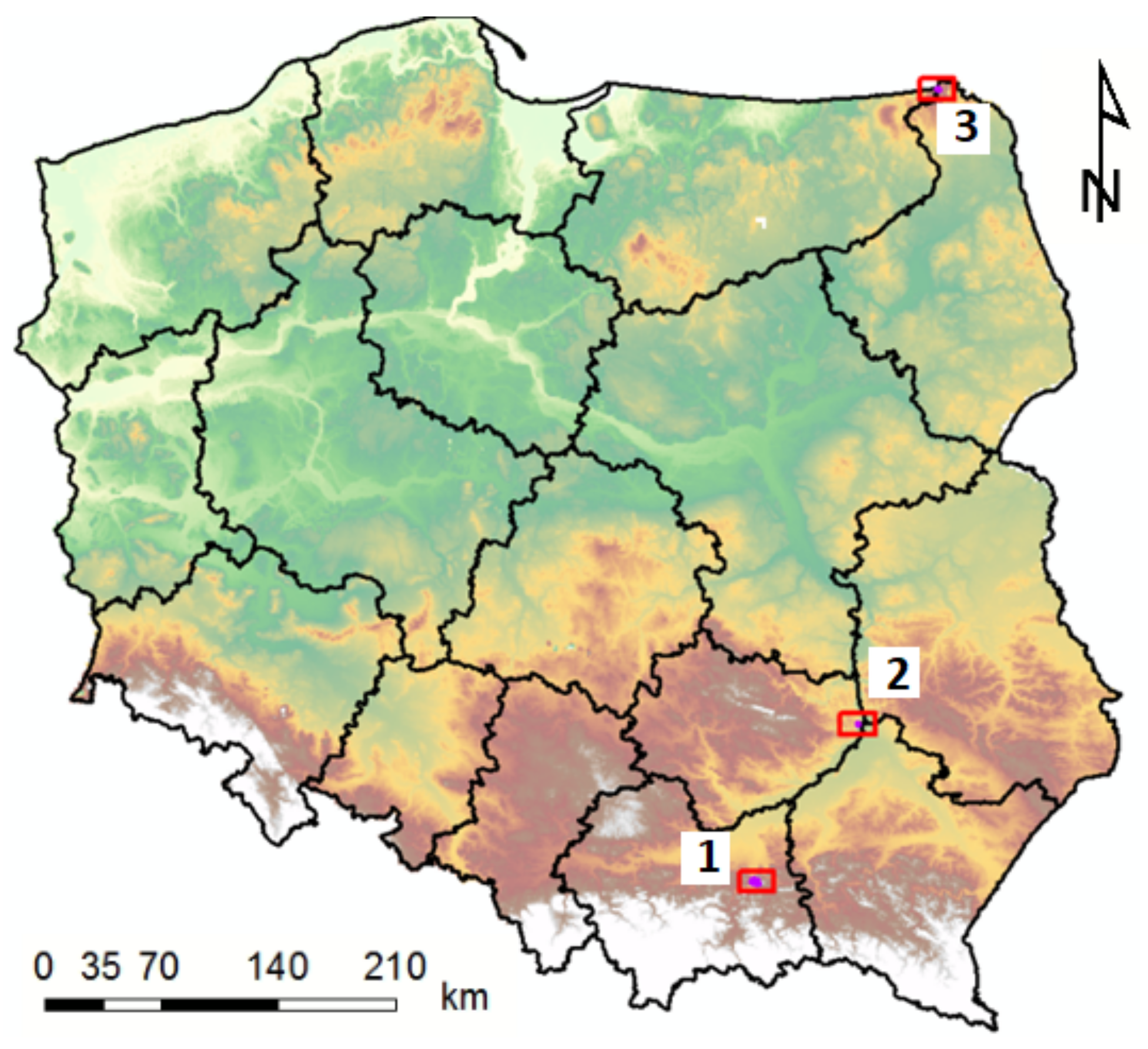
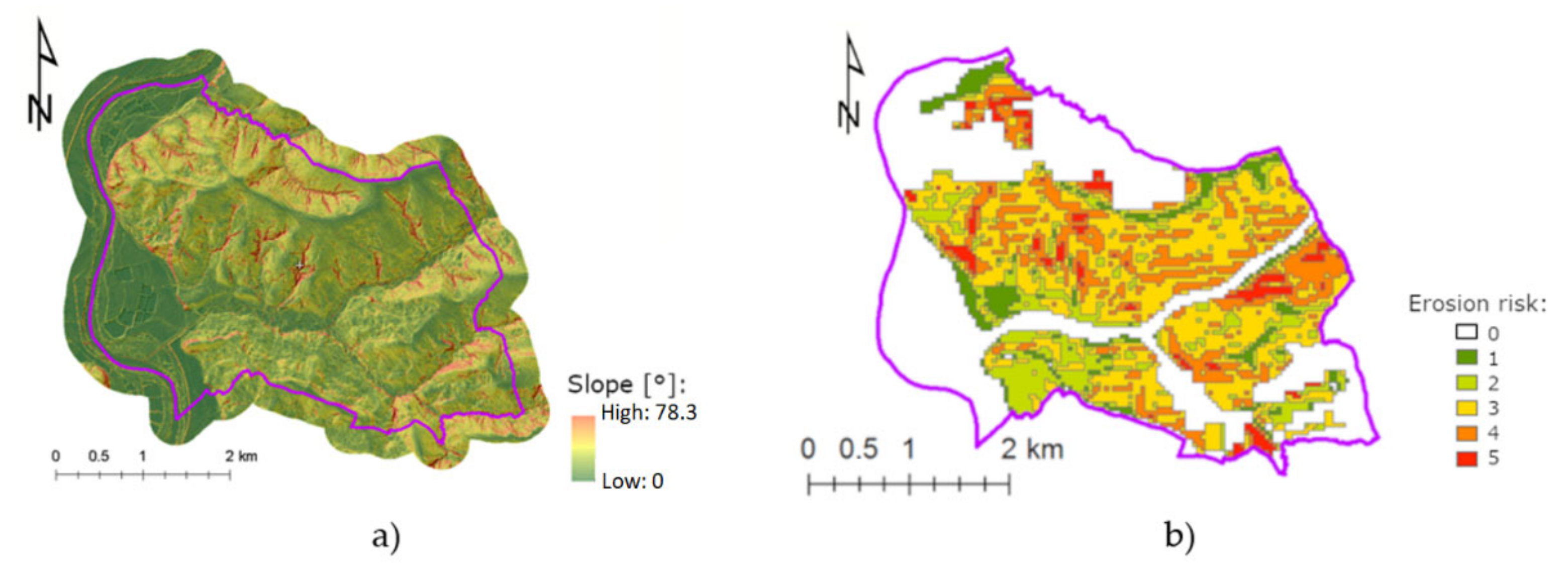
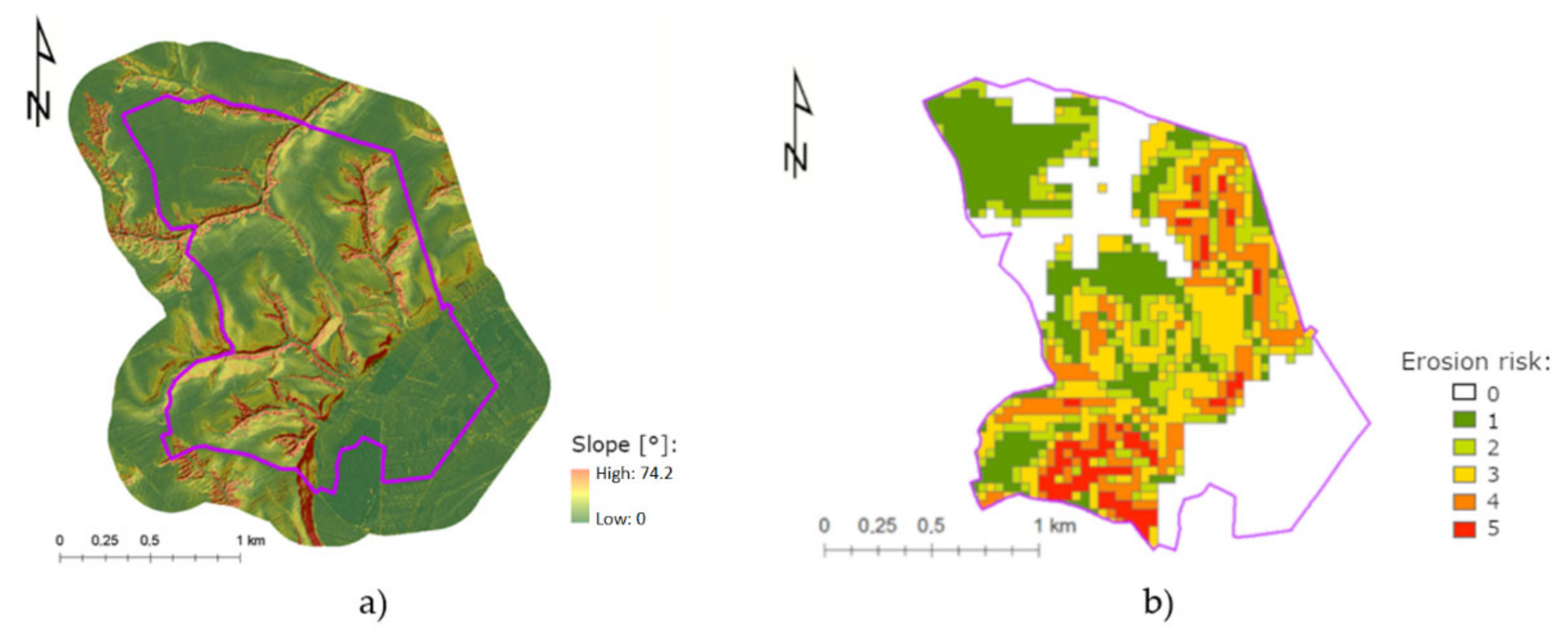
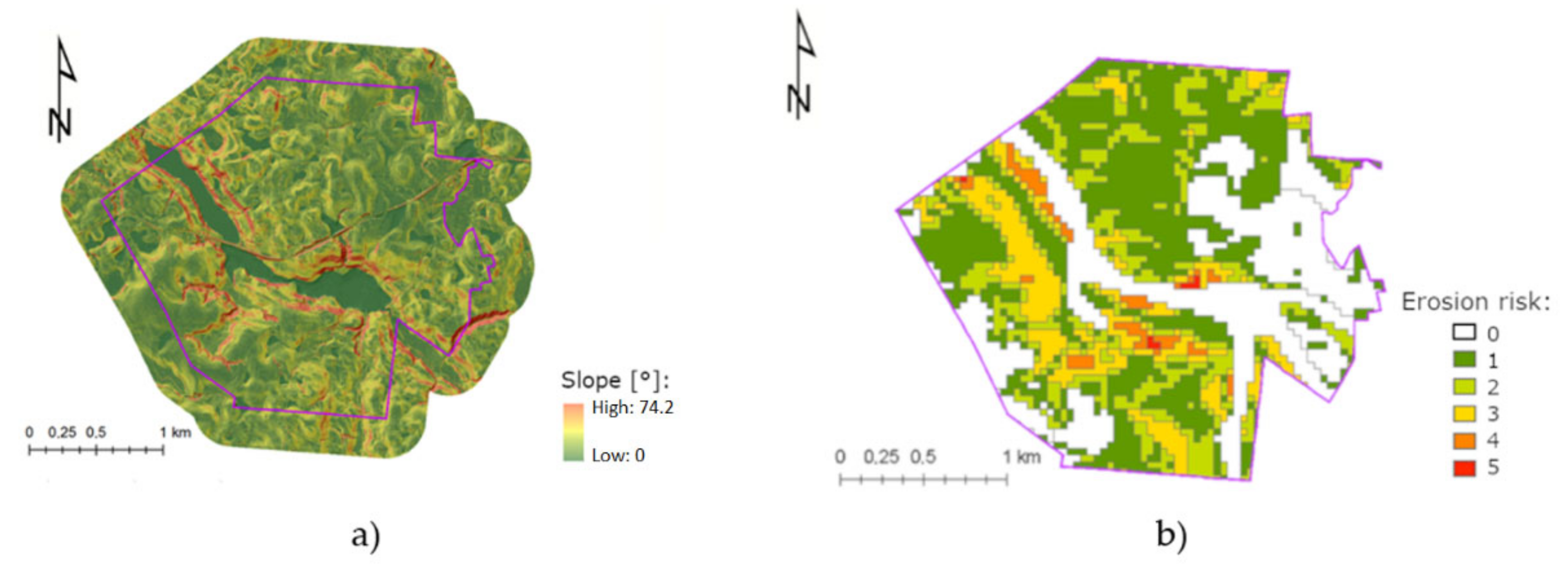
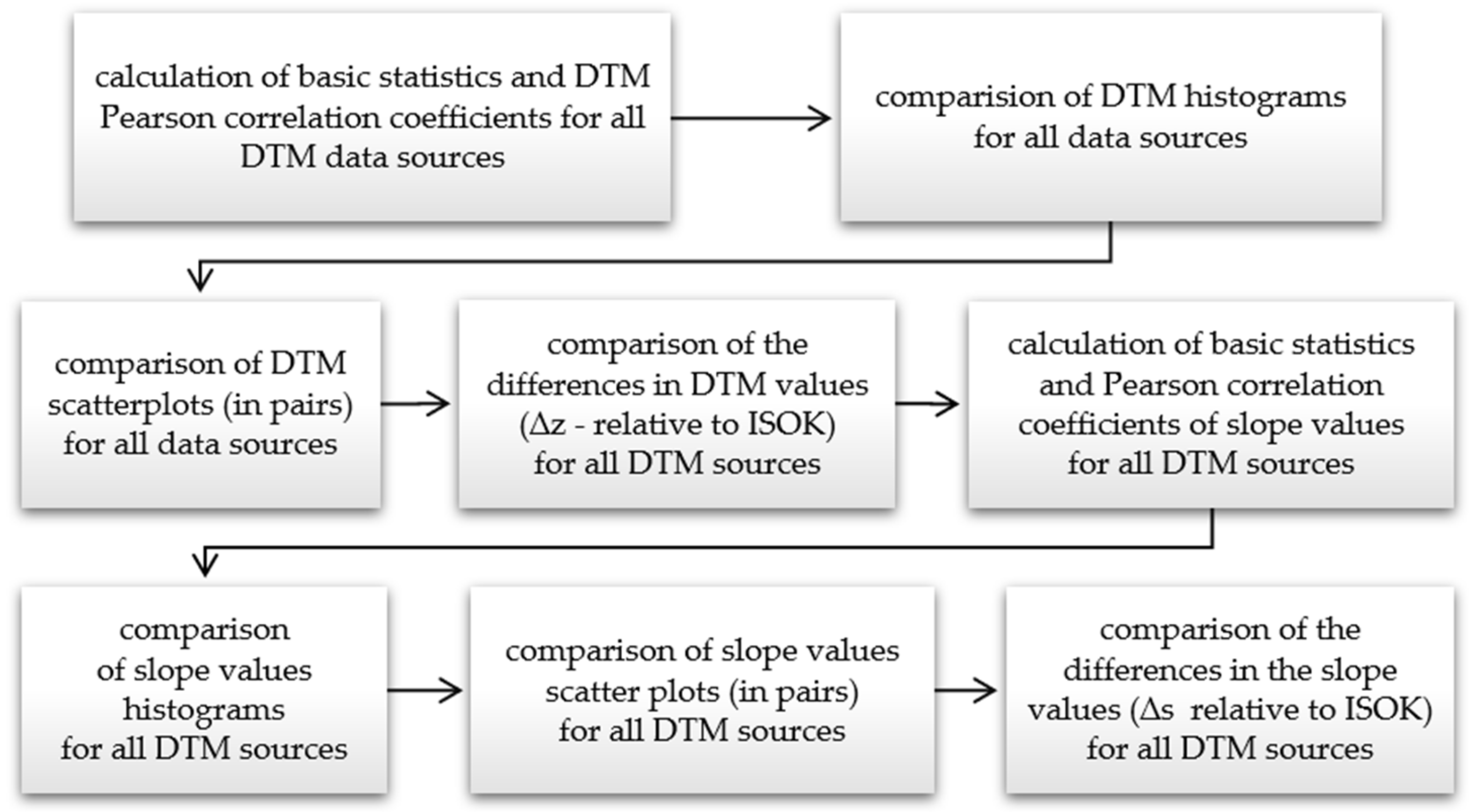

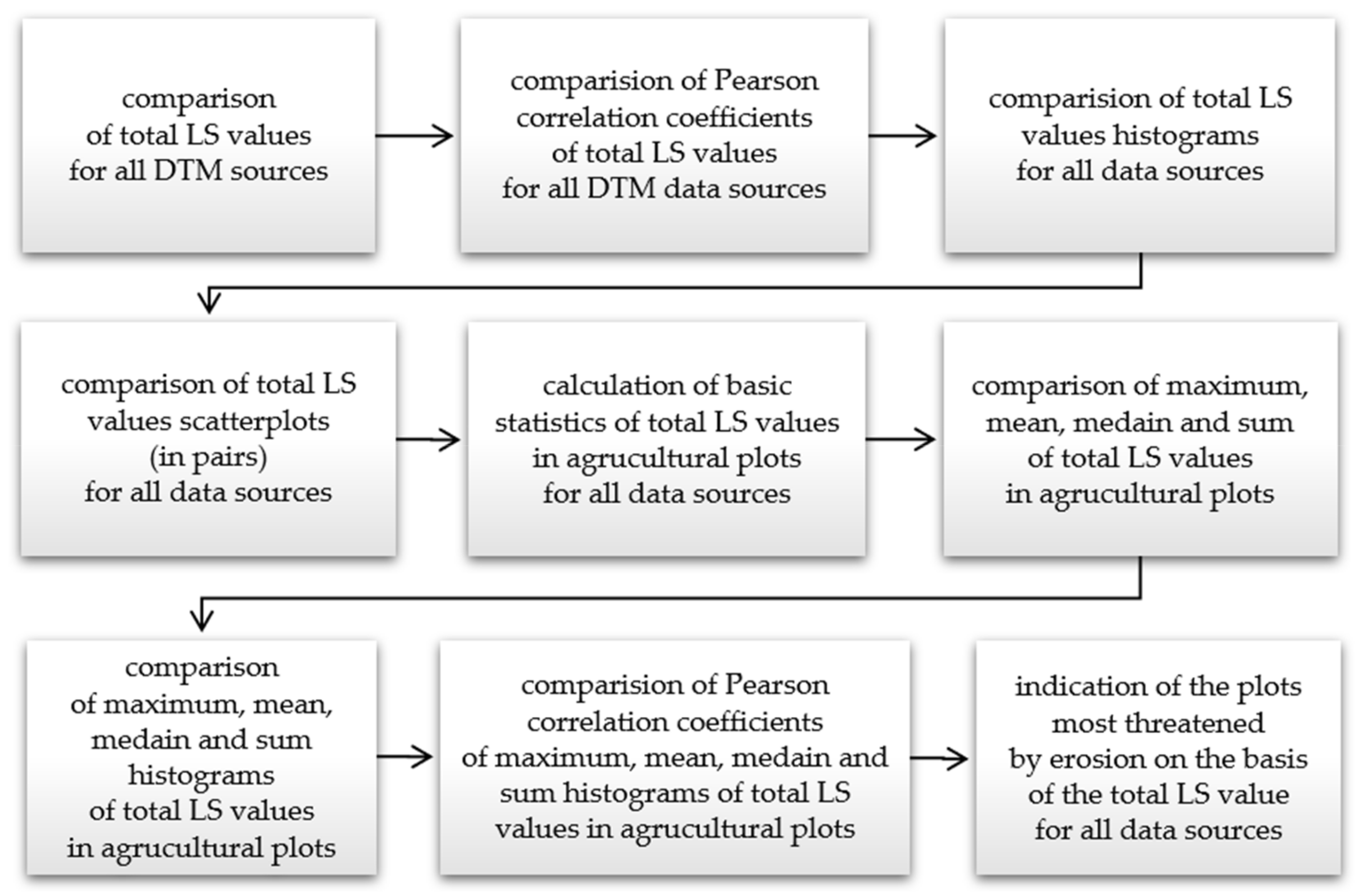
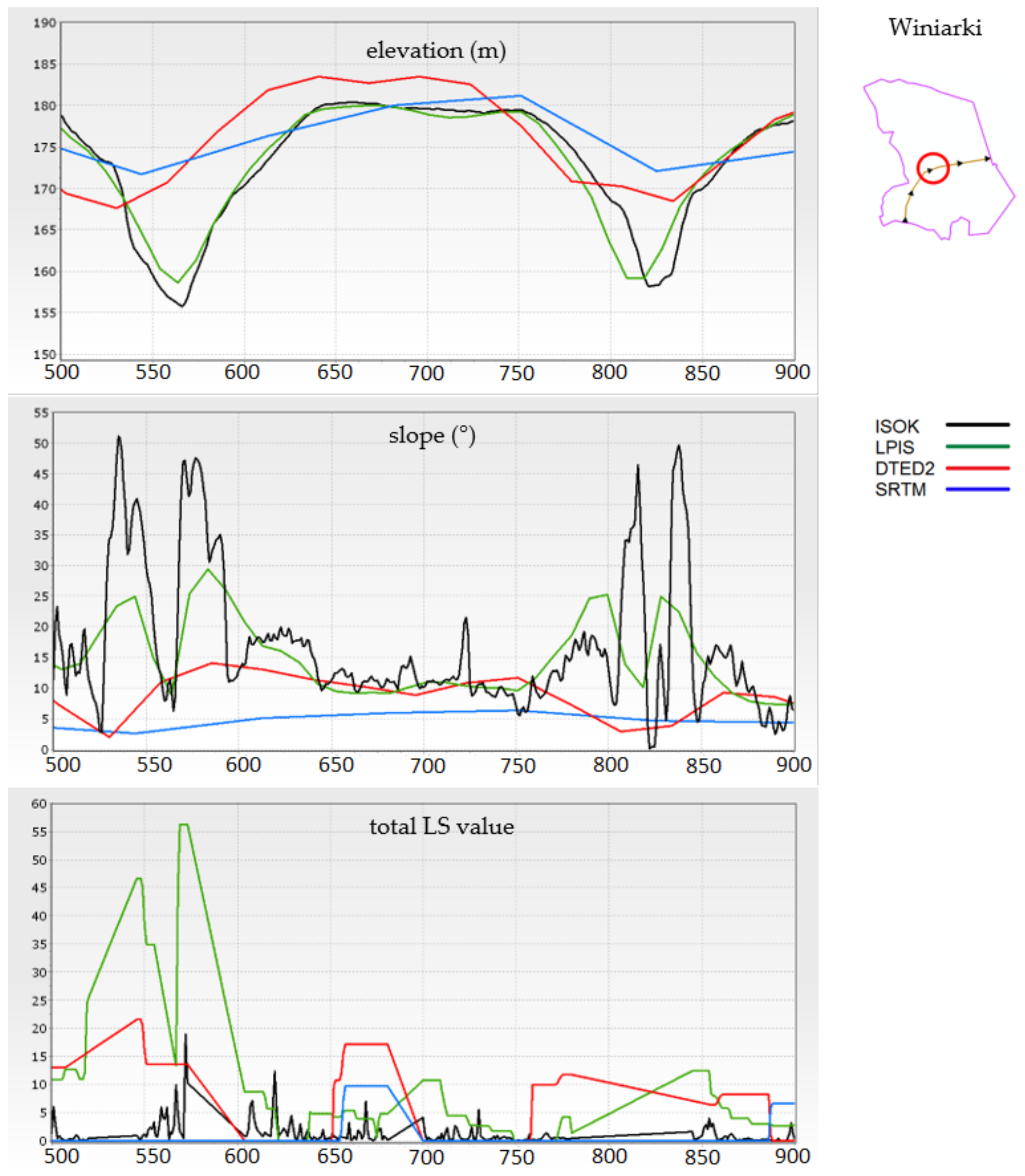
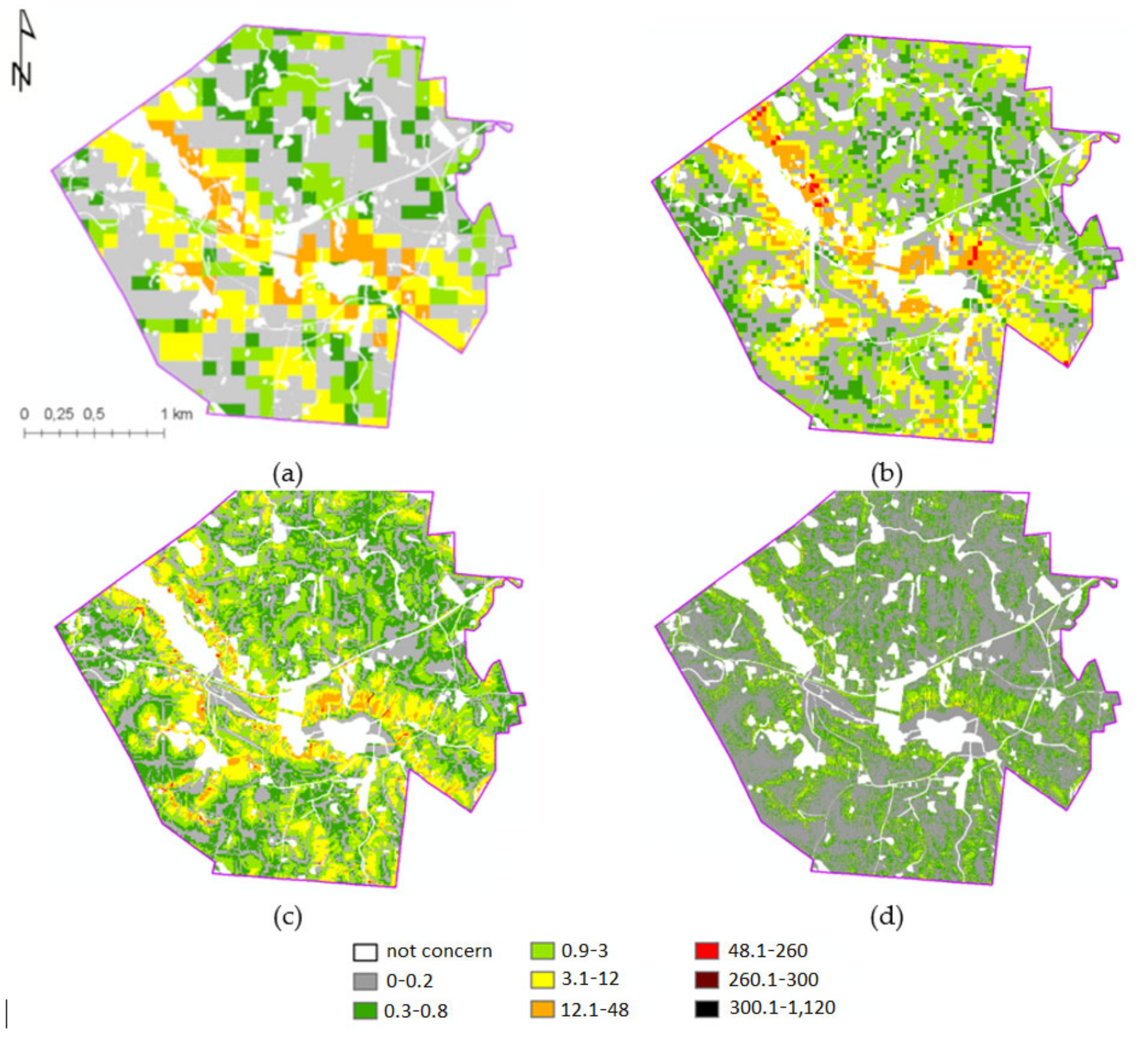

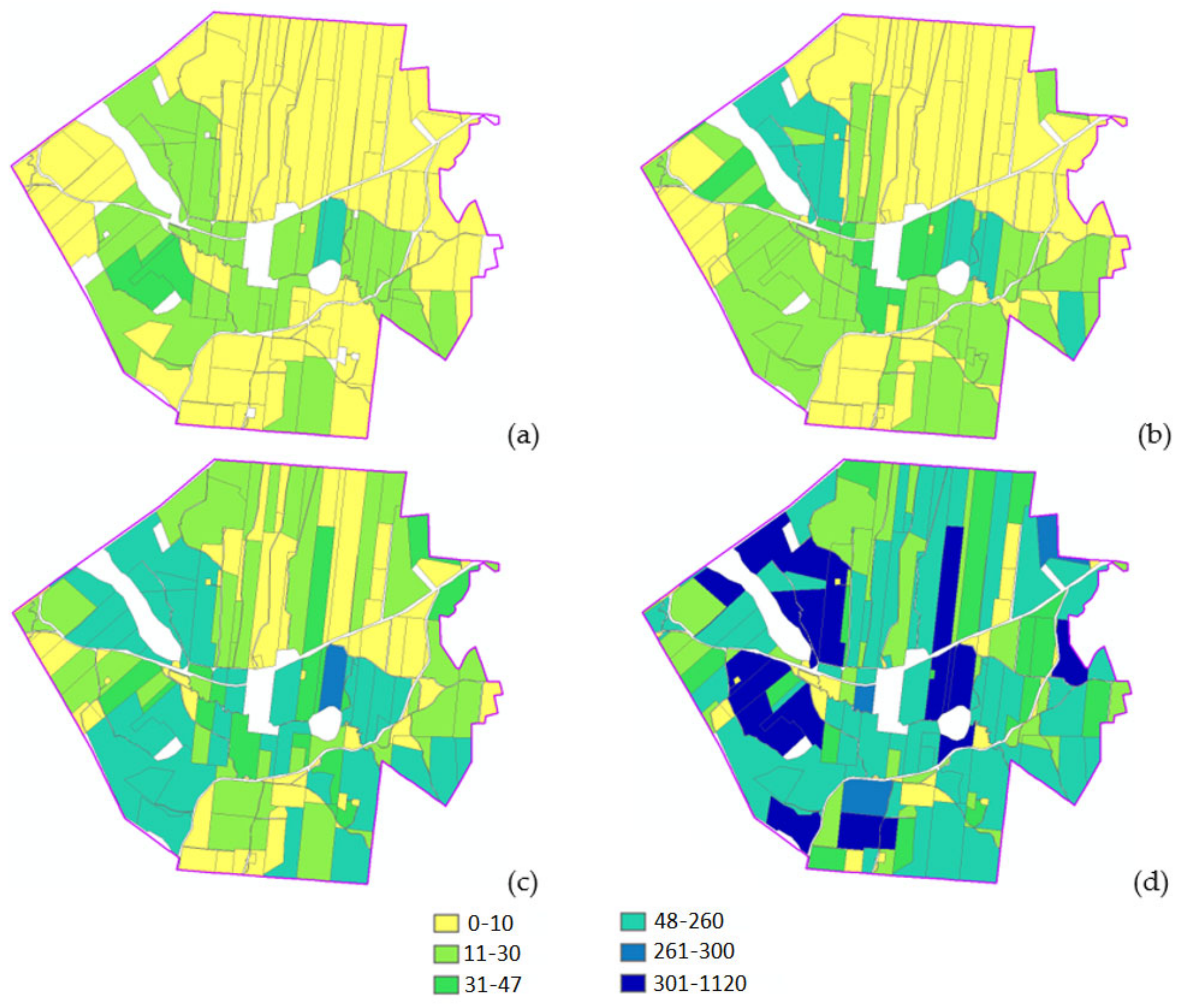
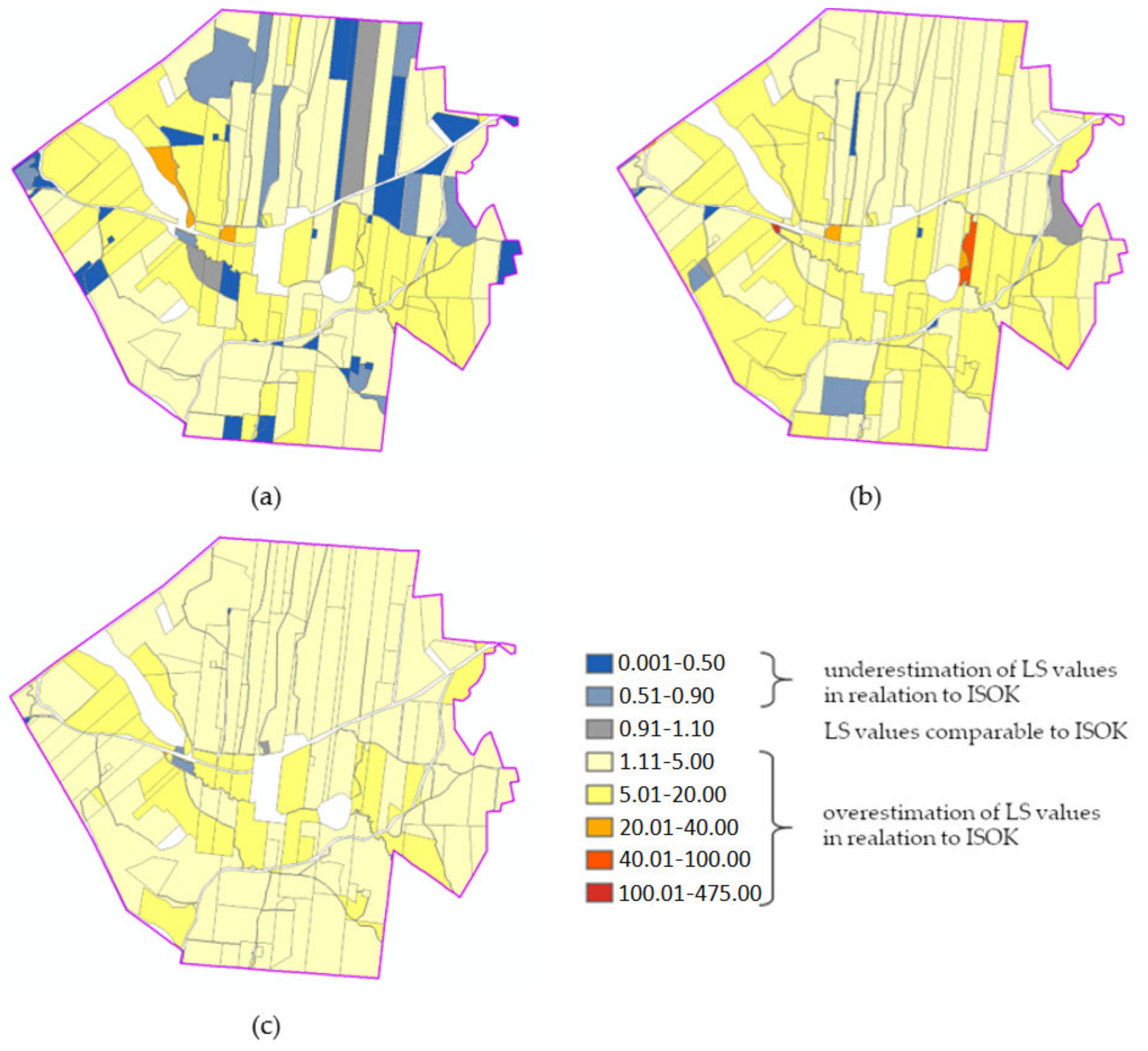
| No | Max Loss t/ha/y | Mean Loss t/ha/y | Equation | DTM Source | DTM res. [m] | Flow | Flow Algorithm | Research Date | Research Localisation | Research Area | Region | Country | Publication Date | Bibliography |
|---|---|---|---|---|---|---|---|---|---|---|---|---|---|---|
| - | 20.5 | U | chart/table | - | - | - | 60′ 70′ | USA | field | - | USA | 1978 | [17] | |
| - | 28.1 | R | chart/table | - | - | - | 80′ | Indiana | field | - | USA | 1991 | [63] | |
| - | 17 | field | - | 1955–1995 | field | - | Europe | 1995 | [64] | |||||
| - | 0.84 | field | - | 50′ | field | - | Europe | 1995 | [65] | |||||
| - | 10–20 | field | - | - | - | - | 1950–2010 | 1056 plots | field | - | Europe | 2012 | [66] | |
| 1 | - | 0.5 | U | Topo map 10k | 5 | a | MFD | 90′ | Ganspoel catchment | 2.1 km² | Flanders | BE | 1996 | [19] |
| 2 | - | 4.1 | R | Topo map 10k | 10 | l | SFD (Rho8) | 1993–1995 | Kemmelbeek Watershed | 1075 ha | Flanders | BE | 2000 | [67] |
| 3 | - | 11.1 | R | USGS HYDRO1k | 1,000 | l | - | 80′ | - | - | - | Europe | 2003 | [68] |
| 4 | >20 | 1 | U | SRTM | 100 | l | - | - | - | - | - | Europe | 2010 | [32] |
| 5 | 16 | 1.18 | U | Swisstopo | 25 | l | - | 2006/2007 | Urseren Valley | 67 km² | Central CH Alps | CH | 2010 | [69] |
| 6 | 97.8 | - | R | SRTM | 90 | a | - | - | - | 15,183 km² | Małopolskie Voivodship | PL | 2012 | [35] |
| 57 | >30 | - | U | - | 21 | l | - | 2009 | test field near Gorajec | 84 km² | Roztocze region | PL | 2013 | [38] |
| 8 | >15 | 4.3 | U | - | 20 | a | MFD (D∞) | 2004–2008 | - | 21,115 km² | Hesse | DE | 2013 | [52] |
| 9 | 13.8 | 3.8 | U | aerial images | 15 | a | - | 1981–2009 | - | 15,183 km² | Małopolskie | PL | 2014 | [70] |
| 10 | - | 19 | U | - | - | l | - | - | part of Bystrzyca Dusznicka | 8.8 km² | Dolnośląskie | PL | 2012 | [71] |
| 11 | >200 | 14.1 | R | Topo map | 14.98 | a | - | - | Herdade do Roncão | 739 ha | region of Alentejo | PT | 2012 | [72] |
| 12 | >30 | 15.1 | R | SRTM | 30 | a | - | 2006–2009 | Alqueva reservoir | 250 km² | region of Alentejo | PT | 2014 | [73] |
| 13 | 6.4 | 0.5 | U | FÖMI. DDM-5 | 5 | a | 2008–2009 | Farkas Ditch catchment | 0.6 km2 | Sopron Hills | HU | 2012 | [74] | |
| 14 | 40 | 5.65 | R | Topo map 10k | - | l | - | 2006 | Turbolo catchment | 30 km² | Calabria | IT | 2016 | [75] |
| 15 | >40 | 9.02 | R | - | 25 & 10 | a | MFD (D∞) | 1955–2002 | Salandrella-Cavone | 74 km² | Basilicata Region | IT | 2008 | [76] |
| 16 | >50 | 1.8 | R | Regione Lombardia | 90 & 20 | a | - | - | Adda river basin | 5170 km² | Rhaetian Alps | IT. CH | 2011 | [77] |
| 17 | >50 | - | R | - | 90 | a | - | - | Upper Soča/Isonzo basin | 1300km² | Julian Alps | SLO, IT | 2011 | [77] |
| 18 | >100 | - | R | - | 90 | a | - | 1985–2005 | Alpine River Inn basin | 26,000 km² | - | CH, AT, DE, IT | 2011 | [77] |
| 19 | 5458.6 | 57 | R | - | 20 | l | - | 2001 | Tusciano river basin | 261 km² | Campania Region | IT | 2007 | [78] |
| 20 | 204.6 | - | R | - | 10 | a | MFD (D∞) | - | Arroyo del Lugar basin | 768.62 ha | Guadalajara | ES | 2012 | [79] |
| 21 | 45.8 | 17.4 | R | - | 3 | a | - | 2018 | Tierra de Barros | 20 ha | province of Badajoz | ES | 2020 | [80] |
| 22 | 11,680 | 71.4 | R | - | 5 | a | MFD | - | Camastra river basin | 350 km² | Basilicata Region | IT | 2020 | [81] |
| 23 | >75 | 12.8 | R | - | 20 | - | - | 2002 & 2012 | Cephalonia Island | 773 km² | Cephalonia Island | GR | 2018 | [82] |
| 24 | >50 | 2.46 | R | EU-DEM (STRM + ASTER GDEM) | 25 | a | MFD (TFM) | 2000s | - | - | - | Europe | 2015 | [43] |
| 25 | >50 | 0.89 | R | ASTER GDEM / SRTM | 250 | a | MFD | 2001–2012 | - | - | - | World | 2017 | [28] |
| Dataset Name | Model Type | Absolute Height Accuracy | Spatial Resolution (GRID Structure) | Up-to-Date |
|---|---|---|---|---|
| SRTM | DSM | 1.6 m–7.2 m | 30 m / 90 m | 2000 |
| FDEM / HDEM | DSM | 0.8 m/4–8 m | 6 m | 2017 [97] |
| IDEM | 2 m [98] | 12 m | 2010–2015 | |
| TanDEM-X | <10 m [98] | 90 m | 2010–2015 | |
| DTED2 | DTM | <10 m 1.5 m–7.5 m | 30 m | 1980 [99] |
| ASTER GDEM 2 | DSM | 7 m–14 m | 30 m | 2011 |
| ALOS World 3D v.2.2 | DSM | 5 m | 30 m | 2015–2018 |
| EUDEM | DSM | 7 m | 25 m | 2011 |
| LPIS | DTM | 0.6 m–0.9 m 0.9 m–1.5 m | 10 m 15 m | 2010–2018 |
| ALS / ISOK | DTM. DSM DTM. DSM | 0.10 m (st. I) 0.25 m (st. II) [100] | 0.5 m 1 m | 2010–2018 2010–2018 |
| Data Source | Min | Max | Mean | Median | Standard Deviation | Range Min-Max |
|---|---|---|---|---|---|---|
| Janowice | ||||||
| SRTM | 198 | 410 | 285.5 | 288 | 54.7 | 212 |
| DTED2 | 202 | 416 | 287.1 | 289 | 53.8 | 214 |
| LPIS | 200.2 | 418.1 | 287.5 | 289.6 | 54.3 | 218 |
| ISOK | 201.0 | 418.0 | 287.4 | 289.4 | 54.3 | 217 |
| Winiarki | ||||||
| SRTM | 135 | 199 | 175.4 | 183 | 18.7 | 64 |
| DTED2 | 139 | 206 | 178.3 | 184 | 18.9 | 67 |
| LPIS | 139.1 | 204.6 | 178.8 | 186.2 | 19.7 | 66 |
| ISOK | 138.6 | 205.2 | 179.4 | 186.8 | 19.7 | 67 |
| Bolcie | ||||||
| SRTM | 204 | 260 | 238.8 | 241 | 11.9 | 56 |
| DTED2 | 207 | 264 | 241.3 | 244 | 12.8 | 57 |
| LPIS | 205.4 | 264.4 | 241.0 | 243.6 | 12.7 | 59 |
| ISOK | 206.0 | 266.5 | 241.7 | 244.5 | 12.7 | 61 |
| Janowice | ||||
| ISOK | LPIS | DTED2 | SRTM | |
| ISOK | 1.000 | 1.000 | 0.998 | 0.991 |
| LPIS | 1.000 | 0.998 | 0.992 | |
| DTED2 | 1.000 | 0.989 | ||
| SRTM | 1.000 | |||
| Winiarki | ||||
| ISOK | LPIS | DTED2 | SRTM | |
| ISOK | 1.000 | 0.998 | 0.972 | 0.967 |
| LPIS | 1.000 | 0.975 | 0.969 | |
| DTED2 | 1.000 | 0.956 | ||
| SRTM | 1.000 | |||
| Bolcie | ||||
| ISOK | LPIS | DTED2 | SRTM | |
| ISOK | 1.000 | 0.998 | 0.978 | 0.942 |
| LPIS | 1.000 | 0.979 | 0.949 | |
| DTED2 | 1.000 | 0.933 | ||
| SRTM | 1.000 | |||
| ISOK-SRTM (m) | ISOK-DTED2 (m) | ISOK-LPIS (m) | |||||||
|---|---|---|---|---|---|---|---|---|---|
| Research Area | min Δz | max Δz | mean ǀΔzǀ | min Δz | max Δz | mean ǀΔzǀ | min Δz | max Δz | mean ǀΔzǀ |
| Janowice | −34.5 | 36.3 | ± 5.8 | −27.3 | 22.1 | ± 2.5 | −11.0 | 14.0 | ± 0.7 |
| Winiarki | −24.4 | 34.5 | ± 5.4 | −23.4 | 35.3 | ± 3.0 | −14.0 | 12.7 | ± 1.0 |
| Bolcie | −22.4 | 25.1 | ± 4.1 | −13.1 | 20.5 | ± 2.0 | −6.0 | 7.9 | ± 0.9 |
| Data Source | Min | Max | Mean | Median | Standard Deviation | Range Min-Max |
|---|---|---|---|---|---|---|
| Janowice | ||||||
| SRTM | 0.0 | 16.4 | 6.5 | 7.1 | 3.3 | 16.4 |
| DTED2 | 0.0 | 27.4 | 7.9 | 8.2 | 4.3 | 27.4 |
| LPIS | 0.0 | 41.5 | 8.6 | 8.7 | 5.1 | 41.5 |
| ISOK | 0.0 | 65.9 | 9.4 | 8.8 | 6.5 | 65.9 |
| Winiarki | ||||||
| SRTM | 0.0 | 12.0 | 2.8 | 2.2 | 2.0 | 12.0 |
| DTED2 | 0.0 | 32.2 | 6.2 | 4.6 | 5.6 | 32.2 |
| LPIS | 0.0 | 39.0 | 6.2 | 4.5 | 5.9 | 39.0 |
| ISOK | 0.0 | 73.0 | 7.5 | 4.8 | 8.1 | 73.0 |
| Bolcie | ||||||
| SRTM | 0.0 | 8.7 | 2.6 | 2.0 | 1.9 | 8.7 |
| DTED2 | 0.0 | 18.1 | 4.2 | 3.5 | 3.0 | 18.1 |
| LPIS | 0.0 | 32.0 | 5.2 | 4.3 | 4.0 | 32.0 |
| ISOK | 0.0 | 58.7 | 6.3 | 5.1 | 5.4 | 58.7 |
| Janowice | ||||
| ISOK | LPIS | DTED2 | SRTM | |
| ISOK | 1.000 | 0.750 | 0.605 | 0.515 |
| LPIS | 1.000 | 0.792 | 0.682 | |
| DTED2 | 1.000 | 0.735 | ||
| SRTM | 1.000 | |||
| Winiarki | ||||
| ISOK | LPIS | DTED2 | SRTM | |
| ISOK | 1.000 | 0.753 | 0.536 | 0.393 |
| LPIS | 1.000 | 0.669 | 0.523 | |
| DTED2 | 1.000 | 0.559 | ||
| SRTM | 1.000 | |||
| Bolcie | ||||
| ISOK | LPIS | DTED2 | SRTM | |
| ISOK | 1.000 | 0.748 | 0.476 | 0.363 |
| LPIS | 1.000 | 0.656 | 0.516 | |
| DTED2 | 1.000 | 0.659 | ||
| SRTM | 1.000 | |||
| Janowice | ||||
| threshold | SRTM | DTED2 | LPIS | ISOK |
| 95% of research area | 11.3 | 14.6 | 16.8 | 20.5 |
| 99% of research area | 12.9 | 17.3 | 19.9 | 28.1 |
| maximum value | 16.4 | 27.4 | 41.5 | 65.9 |
| Winiarki | ||||
| threshold | SRTM | DTED2 | LPIS | ISOK |
| 95% of research area | 6.9 | 17.1 | 17.1 | 23.1 |
| 99% of research area | 8.4 | 23.1 | 24.2 | 37.7 |
| maximum value | 12.0 | 32.2 | 39.0 | 73.0 |
| Bolcie | ||||
| threshold | SRTM | DTED2 | LPIS | ISOK |
| 95% of research area | 6.1 | 10.2 | 12.8 | 16.1 |
| 99% of research area | 7.7 | 14.5 | 17.1 | 24.9 |
| maximum value | 8.7 | 18.1 | 32.0 | 58.7 |
| Research Area | ISOK-SRTM (°) | ISOK-DTED2 (°) | ISOK-LPIS (°) | ||||||
|---|---|---|---|---|---|---|---|---|---|
| min Δs | max Δs | mean ǀΔsǀ | min Δs | max Δs | mean ǀΔsǀ | min Δs | max Δs | mean ǀΔsǀ | |
| Janowice | −15.7 | 60.6 | ± 4.2 | −26.0 | 61.5 | ± 3.5 | −40.4 | 58.9 | ± 2.7 |
| Winiarki | −10.2 | 68.9 | ± 5.2 | −28.9 | 66.8 | ± 4.2 | −35.1 | 60.0 | ± 2.9 |
| Bolcie | −8.7 | 51.7 | ± 4.3 | −15.0 | 49.8 | ± 3.5 | −24.8 | 47.7 | ± 2.3 |
| Data Source | Min | Max | Mean | Median | Standard Deviation |
|---|---|---|---|---|---|
| Janowice | |||||
| SRTM | 0 | 160.6 | 16.4 | 8.8 | 21.6 |
| DTED2 | 0 | 257.5 | 11.9 | 7.4 | 15.8 |
| LPIS | 0 | 500.6 | 6.0 | 3.1 | 10.0 |
| ISOK | 0 | 3314.9 | 1.0 | 0.2 | 7.1 |
| Winiarki | |||||
| SRTM | 0 | 54.3 | 1.5 | 0.0 | 3.5 |
| DTED2 | 0 | 219.7 | 4.9 | 0.1 | 13.9 |
| LPIS | 0 | 273.6 | 2.4 | 0.5 | 5.9 |
| ISOK | 0 | 824.3 | 0.5 | 0.1 | 3.1 |
| Bolcie | |||||
| SRTM | 0 | 47.1 | 2.4 | 0.0 | 4.9 |
| DTED2 | 0 | 258.2 | 3.3 | 0.7 | 9.2 |
| LPIS | 0 | 297.2 | 2.2 | 0.7 | 5.7 |
| ISOK | 0 | 1116.8 | 0.5 | 0.1 | 3.4 |
| Janowice | ||||
| threshold | SRTM | DTED2 | LPIS | ISOK |
| 95% of research area | 58.5 | 38.4 | 20.0 | 3.4 |
| 99% of research area | 84.7 | 62.8 | 37.5 | 9.8 |
| maximum value | 160.6 | 257.5 | 500.6 | 3314.9 |
| Winiarki | ||||
| threshold | SRTM | DTED2 | LPIS | ISOK |
| 95% of research area | 8.3 | 22.4 | 9.7 | 1.7 |
| 99% of research area | 17.2 | 51.7 | 20.4 | 4.6 |
| maximum value | 54.3 | 219.7 | 273.6 | 824.3 |
| Bolcie | ||||
| threshold | SRTM | DTED2 | LPIS | ISOK |
| 95% of research area | 11.6 | 13.5 | 8.0 | 1.6 |
| 99% of research area | 18.6 | 27.4 | 17.1 | 3.9 |
| maximum value | 47.1 | 258.2 | 297.2 | 1116.8 |
| Janowice | ||||
| ISOK | LPIS | DTED2 | SRTM | |
| ISOK | 1.000 | 0.086 | 0.065 | 0.050 |
| LPIS | 1.000 | 0.321 | 0.257 | |
| DTED2 | 1.000 | 0.444 | ||
| SRTM | 1.000 | |||
| Winiarki | ||||
| ISOK | LPIS | DTED2 | SRTM | |
| ISOK | 1.000 | 0.128 | 0.068 | 0.037 |
| LPIS | 1.000 | 0.118 | 0.108 | |
| DTED2 | 1.000 | 0.215 | ||
| SRTM | 1.000 | |||
| Bolcie | ||||
| ISOK | LPIS | DTED2 | SRTM | |
| ISOK | 1.000 | 0.139 | 0.066 | 0.077 |
| LPIS | 1.000 | 0.237 | 0.274 | |
| DTED2 | 1.000 | 0.378 | ||
| SRTM | 1.000 | |||
| Data Source | Maximum Value | Standard Deviation | Sum | Mean | Median |
|---|---|---|---|---|---|
| Janowice | |||||
| SRTM | 160.6 | 8.0 | 113553 | 16.8 | 15.8 |
| DTED2 | 257.5 | 7.8 | 86158 | 12.1 | 10.7 |
| LPIS | 500.6 | 6.3 | 43231 | 5.8 | 4.1 |
| ISOK | 3314.9 | 4.7 | 7426 | 1.0 | 0.2 |
| Winiarki | |||||
| SRTM | 54.3 | 2 | 9613 | 2.2 | 1.9 |
| DTED2 | 219.7 | 8.5 | 32781 | 4.2 | 2.6 |
| LPIS | 273.6 | 3.6 | 15761 | 1.9 | 1.1 |
| ISOK | 824.3 | 2.3 | 3061 | 0.4 | 0.1 |
| Bolcie | |||||
| SRTM | 47.1 | 1.8 | 51 378 | 2.6 | 2.2 |
| DTED2 | 258.2 | 3.8 | 69 438 | 3.6 | 2.4 |
| LPIS | 297.2 | 3.1 | 45 083 | 2.2 | 1.3 |
| ISOK | 1116.8 | 1.9 | 10 178 | 0.5 | 0.2 |
| Janowice | ||||
| ISOK | LPIS | DTED2 | SRTM | |
| ISOK | 1.000 | 0.959 | 0.874 | 0.733 |
| LPIS | 1.000 | 0.887 | 0.750 | |
| DTED2 | 1.000 | 0.825 | ||
| SRTM | 1.000 | |||
| Winiarki | ||||
| ISOK | LPIS | DTED2 | SRTM | |
| ISOK | 1.000 | 0.967 | 0.715 | 0.519 |
| LPIS | 1.000 | 0.713 | 0.608 | |
| DTED2 | 1.000 | 0.596 | ||
| SRTM | 1.000 | |||
| Bolcie | ||||
| ISOK | LPIS | DTED2 | SRTM | |
| ISOK | 1.000 | 0.965 | 0.793 | 0.784 |
| LPIS | 1.000 | 0.818 | 0.812 | |
| DTED2 | 1.000 | 0.794 | ||
| SRTM | 1.000 | |||
| Janowice | ||||
| ISOK | LPIS | DTED2 | SRTM | |
| ISOK | 1.000 | 0.256 | 0.219 | 0.150 |
| LPIS | 1.000 | 0.483 | 0.422 | |
| DTED2 | 1.000 | 0.605 | ||
| SRTM | 1.000 | |||
| Winiarki | ||||
| ISOK | LPIS | DTED2 | SRTM | |
| ISOK | 1.000 | 0.337 | 0.266 | 0.068 |
| LPIS | 1.000 | 0.384 | 0.221 | |
| DTED2 | 1.000 | 0.426 | ||
| SRTM | 1.000 | |||
| Bolcie | ||||
| ISOK | LPIS | DTED2 | SRTM | |
| ISOK | 1.000 | 0.544 | 0.499 | 0.487 |
| LPIS | 1.000 | 0.601 | 0.629 | |
| DTED2 | 1.000 | 0.628 | ||
| SRTM | 1.000 | |||
| Janowice | Bolcie | Winiarki | |||||||
|---|---|---|---|---|---|---|---|---|---|
| SRTM | DTED2 | LPIS | SRTM | DTED2 | LPIS | SRTM | DTED2 | LPIS | |
| % of values lower than ISOK | 9.2 | 1.0 | 0.6 | 27.6 | 2.9 | 2.3 | 15.3 | 1.9 | 0.2 |
| % of values equal to ISOK | 0.9 | 0.6 | 0.6 | 5.3 | 1.0 | 1.7 | 3.7 | 1.1 | 0.1 |
| % of values higher than ISOK | 89.9 | 98.4 | 98.8 | 67.1 | 96.1 | 95.9 | 81.0 | 97.0 | 99.7 |
Publisher’s Note: MDPI stays neutral with regard to jurisdictional claims in published maps and institutional affiliations. |
© 2021 by the author. Licensee MDPI, Basel, Switzerland. This article is an open access article distributed under the terms and conditions of the Creative Commons Attribution (CC BY) license (http://creativecommons.org/licenses/by/4.0/).
Share and Cite
Fijałkowska, A. Analysis of the Influence of DTM Source Data on the LS Factors of the Soil Water Erosion Model Values with the Use of GIS Technology. Remote Sens. 2021, 13, 678. https://doi.org/10.3390/rs13040678
Fijałkowska A. Analysis of the Influence of DTM Source Data on the LS Factors of the Soil Water Erosion Model Values with the Use of GIS Technology. Remote Sensing. 2021; 13(4):678. https://doi.org/10.3390/rs13040678
Chicago/Turabian StyleFijałkowska, Anna. 2021. "Analysis of the Influence of DTM Source Data on the LS Factors of the Soil Water Erosion Model Values with the Use of GIS Technology" Remote Sensing 13, no. 4: 678. https://doi.org/10.3390/rs13040678
APA StyleFijałkowska, A. (2021). Analysis of the Influence of DTM Source Data on the LS Factors of the Soil Water Erosion Model Values with the Use of GIS Technology. Remote Sensing, 13(4), 678. https://doi.org/10.3390/rs13040678





